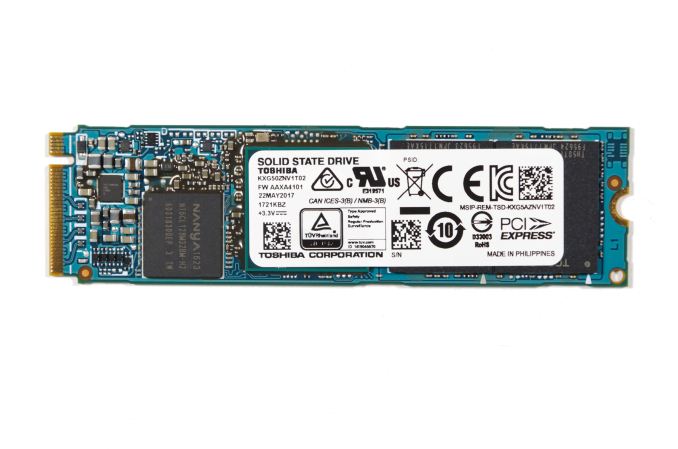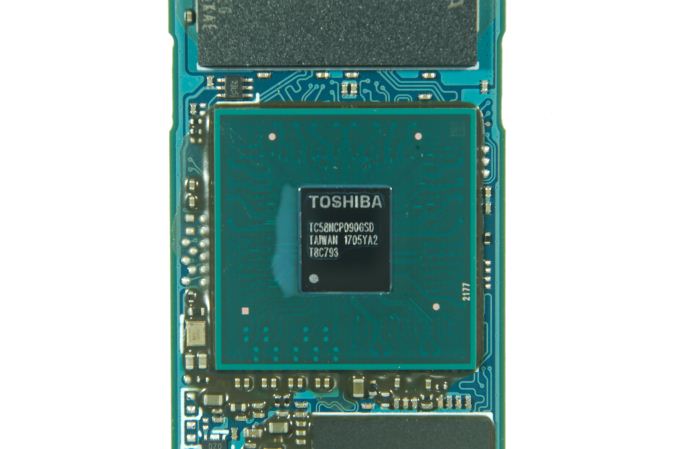The Toshiba XG5 (1TB) SSD Review
by Billy Tallis on August 3, 2017 9:01 AM EST
For several years, 3D NAND flash memory has promised to bring improvements to the performance, endurance and cost of SSDs. Samsung was the first to deliver 3D NAND and they have dominated the market ever since with the fastest consumer SSDs and the highest capacities. Last year, Intel and Micron shipped their first generation of 3D NAND and started providing stronger competition for Samsung in a few market segments, but price improvements were forestalled by the onset of an industry-wide shortage of NAND flash memory. Meanwhile, Toshiba, Western Digital/SanDisk, and SK Hynix talked a lot about their 3D NAND technology but shipped very little. A few memory cards and smartphones last year used 3D NAND, but Toshiba's first SSD with 3D NAND didn't enter mass production until around the beginning of this year, and it was a low-volume niche product.
Toshiba's 3D NAND, now in its third generation, is finally ready for primetime. Their first SSD based on their 64-layer BiCS3 3D NAND is the XG5 client NVMe SSD for the OEM market. Using their 3D TLC NAND, the XG5 is intended as the successor to both their XG3 and XG4 SSDs, which use 15nm planar MLC and TLC respectively. The trend of replacing planar MLC with 3D TLC is widespread across all segments of the SSD market, even for high-end enterprise SSDs. The general consensus has been that the extra capacity of TLC can make up for its performance disadvantages once the switch to 3D NAND has reduced those disadvantages. In the client space, the use of SLC write caching completely eliminates the penalty to write performance provided the workload's writes fit in that cache. Overall, Toshiba's decision to make the TLC-based XG5 their high-end OEM NVMe offering is no surprise.
The XG5 was first teased by Toshiba in May and was officially announced for Computex. The XG5 seems to have been the first 64-layer 3D NAND SSD to start shipping, but since it is an OEM product working its way through the suppy chain, it is still hard for consumers to acquire. Intel launched their 64-layer 3D NAND with the SSD 545s at the end of June and it managed to be the first 64L 3D NAND with retail availability. Since then, Western Digital has also announced their first 3D NAND SSDs, Toshiba announced their first retail 3D NAND SSD, and today Toshiba is announcing the rest of their OEM client 3D NAND SSDs. SK Hynix is still pretty quiet, but otherwise the SSD industry is finally reaching the point where most products will be based on 3D NAND. Planar NAND won't disappear for quite a while, but as production of 64L 3D NAND ramps up most brands will introduce their most significant product updates in years.
| Toshiba XG5 Specifications | |||
| Capacity | 256GB | 512GB | 1024GB |
| Controller | Toshiba TC58NCP090GSD | ||
| NAND Flash | 256Gb 64L 3D TLC | 512Gb 64L 3D TLC | |
| Sequential Read | 2700 MB/s | 3000 MB/s | 3000 MB/s |
| Sequential Write | 1050 MB/s | 1050 MB/s | 2100 MB/s |
| TCG Opal Encryption | Optional | ||
| Form Factor | single-sided M.2 2280 | ||
The Toshiba XG5 is intended to ride the wave of increasing NVMe adoption by OEMs. It uses the single-sided M.2 form factor preferred for notebooks and offers capacities from 256GB to 1TB. Higher capacities would be possible using this 3D NAND, but given the current shortage they would be too expensive for most consumers. The controller supports a PCIe 3.1 x4 link and complies with version 1.2.1 of the NVMe specification. Based on the chip markings (TC58NCP090GSD) it appears to be an updated version of the controller used by the XG3 and RD400 (TC58NCP070GSB), with a switch from plastic packaging to exposed-die flip chip packaging. The die size is approximately 39mm². The only performance specifications provided are for sequential transfers, but they're pretty aggressive for a TLC-based SSD. Toshiba wants the XG5 to cover a broad portion of the OEM SSD market.
We're still in the process of rolling out our new 2017 SSD test suite to replace the 2015 test suite. Our AnandTech Storage Bench (ATSB) tests based on real-world workloads are largely unchanged though we're reporting some of the results a bit differently. Our suite of synthetic tests has been overhauled to be more streamlined and less susceptible to producing unrealistic results due to thermal throttling or SLC write caches filling up. Most of the drives that have been tested so far are PCIe SSDs, so this review does not include any SATA drives for comparison in the graphs. This review compares the 1TB Toshiba XG5 against the following competitors:
- Samsung's 1TB 960 EVO, their current retail NVMe SSD using 3D TLC NAND. Results for the MLC-based 960 PRO and 950 PRO are also included
- Toshiba's 1TB OCZ RD400, the retail counterpart to the Toshiba XG3. The RD400 uses Toshiba's 15nm planar MLC NAND.
- Western Digital's 512GB WD Black and Intel's 512GB SSD 600p These are the cheaper TLC-based NVMe SSDs already on the market. The WD Black uses SanDisk 15nm TLC and the Intel 600p uses 32-layer 3D TLC NAND.
- Plextor M8PeY 512GB and Patriot Hellfire 480GB: Two NVMe SSDs using Toshiba's 15nm planar MLC with Marvell and Phison controllers, respectively. They have generally been cheaper than Toshiba's OCZ RD400.
- The Intel SSD 750 1.2TB, the first NVMe SSD marketed to consumers.
| AnandTech 2017 SSD Testbed | |
| CPU | Intel Xeon E3 1240 v5 |
| Motherboard | ASRock Fatal1ty E3V5 Performance Gaming/OC |
| Chipset | Intel C232 |
| Memory | 4x 8GB G.SKILL Ripjaws DDR4-2400 CL15 |
| Graphics | AMD Radeon HD 5450, 1920x1200@60Hz |
| Software | Windows 10 x64, version 1703 |
| Linux kernel version 4.12, fio version 2.21 | |
- Thanks to Intel for the Xeon E3 1240 v5 CPU
- Thanks to ASRock for the E3V5 Performance Gaming/OC
- Thanks to G.SKILL for the Ripjaws DDR4-2400 RAM
- Thanks to Corsair for the RM750 power supply, Carbide 200R case, and Hydro H60 CPU cooler











28 Comments
View All Comments
Billy Tallis - Monday, August 7, 2017 - link
We always try to get as many different capacities as possible. Some vendors are more willing than others to sample one of each size. Lately with the flash shortage, most vendors have been hesitant to send the full range of samples, and even after the product launches their PR teams have pretty limited sample availability.When I'm reviewing a single drive, I try to include primarily other drives from the same capacity class. If you want to compare eg. a 250 GB NVMe drive against a 512GB SATA drive, that's what our Bench database is for. (Though I haven't posted the 2017 results to Bench yet, and won't have time for that until after Flash Memory Summit.)
Bullwinkle J Moose - Thursday, August 3, 2017 - link
NewEgg insiders could buy the Samsung 850 Pro this week for $109 (256GB)A 10 year warranty on the Worlds Fastest consumer SATA drive turned out to be less expensive than a slower TLC drive with 3 - 5 year warranty then adding an extended warranty
Or you could just save $10 and get a slower TLC drive with a crappy warranty
Your choice
Kwarkon - Saturday, August 12, 2017 - link
Hi, you state that you have L1.2 enabled in your Idle powertest but clearly it is not working on your setup.I guess you use PCIe vertical to m.2 adapter and because of that you cannot go lower than L1.
SanX - Monday, August 14, 2017 - link
A year later and still 3x slower then Samsung 960 ? Why this company still exists?